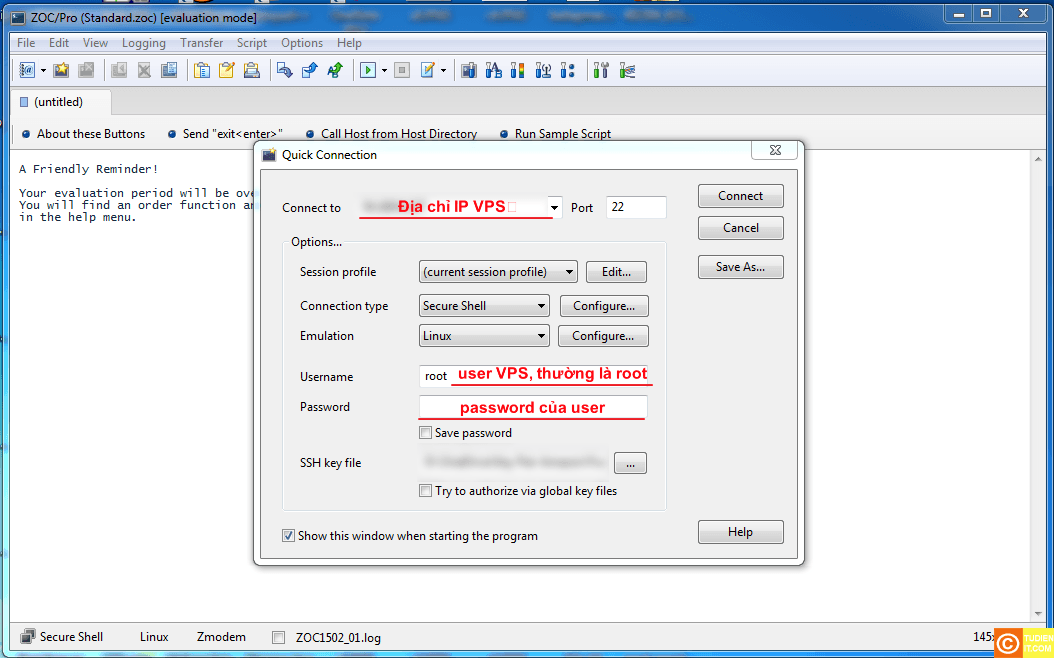
- Zoc terminal tutorial serial port how to#
- Zoc terminal tutorial serial port serial#
- Zoc terminal tutorial serial port pro#
- Zoc terminal tutorial serial port code#
Zoc terminal tutorial serial port serial#
You may choose to use ReadTo(" bp1 >") for instance. note, but your serial port may be different).
Zoc terminal tutorial serial port pro#
Pro Tabbed sessions allows for easy navigation Tabbed sessions mean that multiple items can be contained within a single window and can be easily navigated by the user. There is also ReadTo and ReadLine which you may find useful. Supports serial and dial-up connections In addition to telnet, ssh, and rlogin, ZOC supports direct serial connections, modem dialing, and named pipes. So, it would be recommended to use one of the Read methods instead (see docs). These might involve a thread the you create to poll, but more frequently would be simple loops that may or may not block other operations until they complete. Use polling for Command/Response protocols. Within VM Maestro, navigate to: Preferences > Terminal > Cisco Terminal Change Terminal Settings Note: This is a new settings structure starting with Aug. That is, where data is delivered at regular intervals, without specific associated commands that originate from your application.
Zoc terminal tutorial serial port code#
Use event-driven (DataReceived) code for streaming data. This means that your DataReceived event may not even fire at all if there wasn't enough data sent in total yet (it may fire some time later with all the data at once) - but if you quit your program before that, you will never see. Use the BytesToRead property to determine how much data is left to be read in the buffer. The DataReceived event is not guaranteed to be raised for every byte received. There is no other response yet because from the card's perspective you basically started typing the (invalid) command Enter but haven't yet submitted it with the ⏎ Enter key.)Īlso I'd suggest adding the event listener for received data before sending any data, otherwise there would be a race condition in which the card could be responding before you even set up your listener and you would lose part of the data.Īdditional note: Using the DataRecieved event may not even be desirable in your case.

(You currently receive the Enter back as response because that's what you sent out, and the card echoes any incoming characters so it can be used like a shell without blind typing. \r in a C# string.Īlso you don't yet send any actual command. You should probably send the ⏎ Enter key, which is represented on a terminal with the ASCII code 13, i.e.
Zoc terminal tutorial serial port how to#
You are sending the string Enter (like typing ⇧ E, N, T, E, R). A short tutorial on how to setup a serial port communication between a Linux PC/Laptop and a AVR/PIC/MSP430 Microcontroller or Arduino using PySerial and Python. How can I execute firmware via RS232 and interact like PuTTy have done? Private static void DataReceivedHandler(object sender, SerialDataReceivedEventArgs e) MySerialPort.DataReceived += new SerialDataReceivedEventHandler(DataReceivedHandler)

SerialPort mySerialPort = new SerialPort("COM5") Create the serial port with basic settings

I didn't know the firmware source code looks like.īut it could be executed by PuTTy and it's connection was via RS232 Serial Port.Īfter I click Open,press Enter and type command sys: He wants me to develop a C# Console app to execute the firmware. NPort 6450 Models: IEC 6 ESD: Contact: 4 kV Air: 8 kV IEC 6 RS: 80 MHz to 1 GHz: 3 V/m IEC 6 EFT: Power: 1 kV Signal: 0.5 kV IEC 6 Surge: Power: 1 kV IEC 6 CS: 150 kHz to 80 MHz: 3 V/m Signal: 3 V/m IEC 6 PFMF IEC 6 NPort 6600 Models (except -48V/-HV models): IEC 6 ESD: Contact: 4 kV Air: 8 kV IEC 6 RS: 80 MHz to 1 GHz: 3 V/m IEC 6 EFT: Power 1 kV Signal 0.5 kV IEC 6 Surge: Power: 2 kV IEC 6 CS: 150 kHz to 80 MHz: 3 V/m Signal: 3 V/m IEC 6 PFMF IEC 6 NPort 6600-48V Models: IEC 6 ESD: Contact: 4 kV Air: 8 kV IEC 6 RS: 80 MHz to 1 GHz: 3 V/m IEC 6 EFT: Power: 1 kV Signal: 0.It has a firmware on the chip and it can show sensor's temperature.


 0 kommentar(er)
0 kommentar(er)
